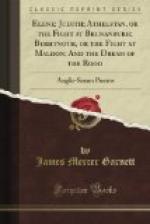II. The JUDITH is a fragment, but a very torso of Hercules. The first nine cantos, nearly three-fourths of the poem, are irretrievably lost, so that we have left but the last three cantos with a few lines of the ninth. The story is from the apocryphal book of Judith, and the part remaining corresponds to chapters XII. 10 to XVI. 1, but the poet has failed to translate the grand thanksgiving of Judith in the sixteenth chapter. The story of Judith and Holofernes is too well known to need narration. The poet, doubtless, followed the Latin Vulgate, as we have no reason to think that a knowledge of Greek was a common possession among Old English poets; but, as Professor Cook says, “the order of events is not that of the original narrative. Many transpositions have been made in the interest of condensation and for the purpose of enhancing the dramatic liveliness of the story.”
The Old English text is found in the same manuscript with the BEOWULF (Cotton, Vitellius, A, xv.), and, to my mind, this poem reminds the reader more of the vigor and fire of BEOWULF than does any other Old English poem; but its author is unknown. It has been assigned by some scholars to the tenth century, which is rather late for it; but Professor Cook has given reasons for thinking that it may have been written in the second half of the ninth century in honor of Judith, the step-mother of King Alfred. It was first printed as prose by Thwaites at the close of his “Heptateuch, Book of Job, and Gospel of Nicodemus” (1698), and has been often reprinted, its shortness and excellence making it a popular piece for inclusion in Anglo-Saxon Readers. A most complete edition has been recently (1888) issued by Professor Albert S. Cook, with an excellent introduction, a translation, and a glossary. A Bibliography is given by Professor Cook (pp. 71-73), and by Wuelker (Grundriss, p. 140 ff.). To the translations therein enumerated may be added the one in Morley’s “English Writers” (II. 180 ff.). Professor Cook has also given (pp. lxix-lxxii) the testimonies of scholars to the worth of this poem. To these the attention of the reader is especially called. The JUDITH has been treated by both ten Brink and Wuelker as belonging to the Caedmon circle, but the former well says (p. 47): “This fragment produces an impression more like that of the national epos than is the case with any other religious poetry of that epoch;” and Sweet (Reader, p. 157) regards it as belonging “to the culminating point of the Old Northumbrian literature, combining as it does the highest dramatic and constructive power with the utmost brilliance of language and metre.”




